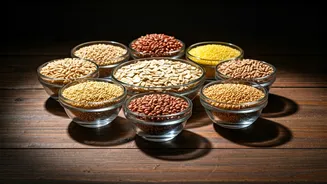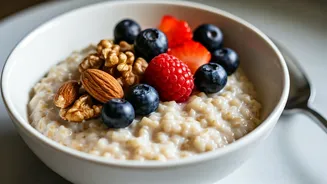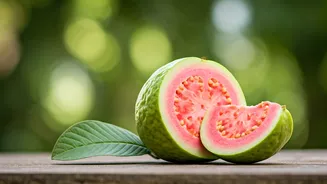Introduction: Diabetes and Grains
Diabetes management involves various lifestyle modifications, and dietary choices are very important. The food choices directly impact blood glucose levels
and overall well-being. Grains are a staple food, but the glycemic index (GI) and the impact they have on blood sugar vary. Opting for grains with a lower GI is vital to help control blood sugar spikes and offer sustained energy. This allows individuals with diabetes to enjoy varied meals while maintaining stable glucose levels, which reduces the risk of long-term complications. The right grain choices are a cornerstone of a diabetes-friendly diet. Choosing the proper grains supports long-term health.
Oats: Heart-Healthy Choice
Oats are a well-recognized option for diabetics due to their high fiber content, particularly beta-glucan. Beta-glucan helps to slow down the absorption of glucose, which reduces the post-meal blood sugar spikes. It contributes to improved insulin sensitivity. Oats provide sustained energy, helping manage hunger and maintaining stable blood sugar. They are also beneficial for heart health, with the ability to lower cholesterol levels. Oats are easily adaptable. They can be included in breakfast cereals, added to smoothies, or used in baking. The fiber content supports digestive health. Oatmeal is a simple, effective way to help manage blood sugar levels while promoting overall health.
Quinoa: Complete Protein Source
Quinoa stands out as a complete protein. It contains all nine essential amino acids. It has a low glycemic index, making it an excellent option for those with diabetes. Quinoa is rich in fiber. It helps to slow down the absorption of glucose, aiding in blood sugar control. Magnesium in quinoa contributes to improved insulin sensitivity, which is vital for blood sugar regulation. It offers versatility. It can be used in salads, as a side dish, or in soups. Its nutty flavor and satisfying texture make it a simple swap for rice or pasta. Quinoa offers essential nutrients. It is a good choice for those seeking to incorporate a healthy and balanced diet.
Barley: Fiber and Flavor
Barley, another fiber-rich grain, is a beneficial addition to a diabetic diet. It has a moderate glycemic index. It helps prevent rapid blood sugar fluctuations. It is high in soluble fiber, which helps to delay glucose absorption and promote feelings of fullness. Barley provides essential nutrients, including vitamins and minerals, which support overall health and well-being. Barley can be used in soups, stews, or as a side dish. It has a slightly chewy texture and nutty flavor, which can enhance various dishes. Barley offers several health benefits. It is a great choice for those looking to manage their blood sugar while enjoying diverse meals.
Brown Rice: Whole Grain Benefits
Brown rice is a whole grain. It provides greater nutritional value than white rice due to the presence of the bran and germ layers. It is rich in fiber, which aids in slowing down glucose absorption, helping to keep blood sugar levels steady. The fiber in brown rice also promotes digestive health and supports satiety. Brown rice contains magnesium, which helps improve insulin sensitivity, contributing to better blood sugar management. It offers essential nutrients. It can be a versatile ingredient in various dishes, including side dishes, salads, and grain bowls. Brown rice is an excellent option for diabetics. It provides essential nutrients and aids in stabilizing blood sugar levels.
Bulgur: Quick and Nutritious
Bulgur is a whole grain made from wheat that is parboiled, dried, and cracked. It has a low glycemic index. It allows for quick cooking times. It is a convenient option for diabetic diets. Bulgur is rich in fiber. It contributes to slower glucose absorption. It prevents spikes in blood sugar. It offers a variety of essential nutrients. Bulgur can be used in salads (like tabbouleh), as a side dish, or in pilafs. It offers a unique texture and flavor. Bulgur provides a convenient and nutritious option. It supports good health and helps manage blood sugar levels.
Buckwheat: Gluten-Free Powerhouse
Buckwheat is often used as a grain substitute. It is naturally gluten-free. It has a low to moderate glycemic index. Buckwheat helps manage blood sugar levels effectively. It is rich in fiber, which supports healthy digestion and slows down glucose absorption. It contains rutin, an antioxidant that has been shown to improve insulin sensitivity and reduce blood sugar levels. Buckwheat can be used in pancakes, noodles (soba), or as a porridge. Buckwheat is a powerful nutritional choice that can boost your diet and help manage blood sugar levels.
Millet: Versatile and Nutritious
Millet is an ancient grain that has gained popularity due to its nutritional benefits. It is gluten-free. It has a moderate glycemic index, making it suitable for those with diabetes. Millet is a good source of fiber, which helps control blood sugar levels. It supports healthy digestion. It provides essential minerals. Millet can be used in porridge, as a side dish, or in salads. It has a mild flavor and can be easily incorporated into many dishes. Millet is a versatile and nutritious grain. It can be a beneficial addition to any diabetic diet.
Cornmeal: Choose Wisely
Cornmeal can be part of a diabetic diet but with careful consideration. The glycemic index of cornmeal can vary. This depends on how it is processed. Opting for whole-grain cornmeal is beneficial, since it retains more fiber. Fiber helps slow down the absorption of glucose and helps to prevent blood sugar spikes. Cornmeal offers nutrients. It is a source of antioxidants. It is essential to monitor portion sizes when using cornmeal. Combine it with protein and healthy fats. This can help to stabilize blood sugar levels. Cornmeal can be a satisfying addition to meals. It is important to make informed choices. This contributes to better blood sugar control.
Amaranth: Ancient Grain Champion
Amaranth, an ancient grain, is packed with nutrients. It has a low glycemic index. It makes it a favorable choice for managing blood sugar levels. It is high in fiber and helps to slow down the digestion and absorption of glucose. It provides essential amino acids. Amaranth is a complete protein. It is rich in minerals such as magnesium. Amaranth can be used as a porridge, in salads, or as a side dish. It has a slightly peppery flavor. Amaranth offers a powerful combination of health benefits. It is a valuable addition to a diet that promotes blood sugar control.












